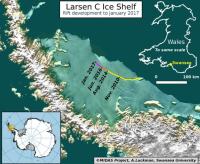 In December of 1893, Captain Carl Anton Larsen, the master of the Norwegian whaling ship Jason, sailed along a vast Antarctic ice shelf in the northwest part of the Weddell Sea on the east coast of the Antarctic Peninsula. Now, just over 120 years later, the ice sheet that bears Larsen’s name is collapsing.
In December of 1893, Captain Carl Anton Larsen, the master of the Norwegian whaling ship Jason, sailed along a vast Antarctic ice shelf in the northwest part of the Weddell Sea on the east coast of the Antarctic Peninsula. Now, just over 120 years later, the ice sheet that bears Larsen’s name is collapsing.
British scientists with Project Midas recently predicted that a widening crack in the ice shelf could cause a 2,000 square mile ice island the size of the State of Delaware to break off this winter. Swansea University’s Adrian Luckman, who heads up Project MIDAS, told the BBC that “If it doesn’t go in the next few months, I’ll be amazed.”
The Larsen ice shelf is made up of three distinct regions — Larsen A, Larsen B and Larsen C. A huge crack in Larsen C, 300 feet wide by about a third of a mile deep, grew dramatically longer this year and only a 12 mile (20 km) strip of ice remains before the ice island breaks off. When it does, it is expected to form one of the ten largest icebergs ever recorded.
Larsen A, the smallest of the three ice shelves, broke apart in January, 1995. Larsen B partially collapsed in 2002, calving an ice sheet the size of Rhode Island. Recent studies suggest that Larsen B will disintegrate by the end of the decade. The expected calving of Larsen C is expected to accelerate the breaking up of the remaining ice shelf. Larsen C is the fourth-largest ice shelf in Antarctica.
The BBC reports: As it floats on the sea, the resulting iceberg from the shelf will not raise sea levels. But if the shelf breaks up even more, it could result in glaciers that flow off the land behind it to speed up their passage towards the ocean. This non-floating ice would have an impact on sea levels. According to estimates, if all the ice that the Larsen C shelf currently holds back entered the sea, global waters would rise by 10cm (4 inches).
